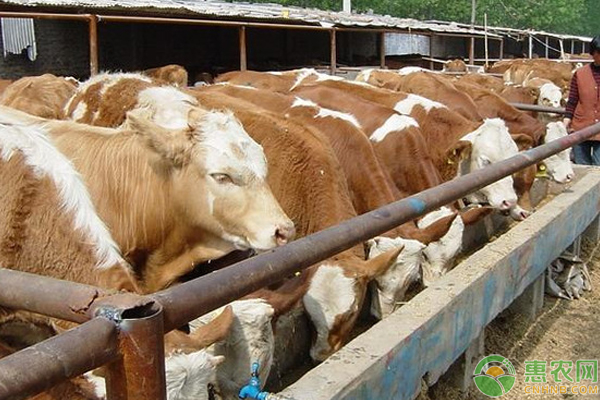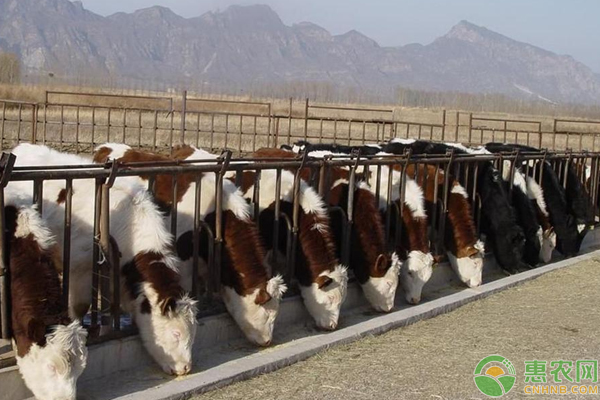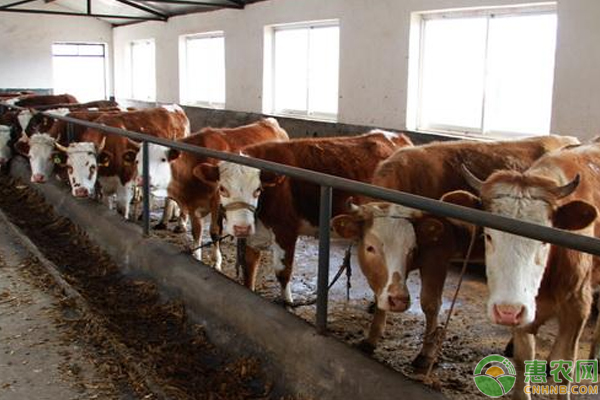The most troublesome thing about cattle breeding is the disease, because once the disease occurs, it is difficult to control, and if the prevention is not timely, it will harm the entire farm. How to prevent and control the disease? The following small series will talk about the main prevention and control measures of beef cattle plague in detail, and hope to help farmers.

    1 Do a good job in health prevention and control of beef cattle farms
Infectious diseases, parasitic diseases, and common diseases are mostly caused by pathogenic bacteria. Therefore, biological prevention and control is one of the most important tasks of beef cattle farms. The following prevention and control measures should be taken.
    1.1 Disinfection
Disinfection is the use of chemical or physical measures to kill the pathogens in the environment, appliances, etc., is one of the important preventive measures. 1 Environmental disinfection: thoroughly clean the cattle farm, pad the ground to prevent water accumulation; remove the weeds, prevent the accumulation of pollutants, regularly kill the rats, and disinfect the drugs once a month. A disinfection tank is installed at the entrance and exit of personnel and vehicles. The disinfection solution is placed in the pool, and the disinfection tank is periodically cleaned and replenished and replaced. 2 Circulation disinfection: the wall, roof and road are disinfected once every 15 days, especially the regular disinfection of the trough and the sink. In practice, the farm often pays attention to the disinfection of the walkway and the cow bed, but ignores the disinfection of the trough and the sink. . 3 Disinfection of breeding equipment: brush once a week with disinfectant. 4 After entering the production area, the keeper must go through the shower and replace the sterilized clothes, hats and shoes to enter the barn.
Disinfection methods: First, physical disinfection, usually with a flame spray gun to disinfect the housing, food trough, walkway, walls and other places that are not easy to burn. Chemical disinfection is disinfectant disinfection. Common chemical disinfectants are 3% sodium hydroxide, 0.3% farm music, 0.2% peracetic acid, 0.5% sodium hypochlorite, 0.1% disinfection, 0.5% poison, 0.2% anti-virus. , 0.05% strong disinfection and quicklime. The common concentration of Xinjieer, Disinfecting and Disinfecting is 0.5‰~1.0‰, which can be used for disinfection of skin, metal instruments and tableware; excellent chlorine can be sprayed, soaked, wiped, or directly disinfected with dry powder. Objects, treatment of excrement such as feces; chlorine dioxide can be used for water disinfection and air disinfection of door guards; quicklime is most commonly used for disinfection of ground environments such as pens and roads.

    1.2 Prevent the introduction of cattle into pathogens
It is necessary to isolate the newly introduced cattle for more than 40 days. According to the standard farming requirements, the isolation of the barn should be no less than 50 m from the main breeding house. Many farmers do not pay much attention to this work. When the barn is built, there is no isolation of the barn or the isolation of the barn and the breeding barn do not have the separation distance between the control and the barn. It is often mixed with the original breeding group or kept separately. Feeding easily causes mutual infection through the trough and the sink. If it is impossible to isolate, it is necessary to disinfect the imported cattle. The cattle should be sprayed with 2% sodium hydroxide solution before entering the house. The equipment used can be disinfected with 0.1% potassium permanganate solution.
    1.3 Prevent infections caused by other animals
The disease of cattle can interact with some diseases of other animals. For example, sporotosis can be infected by dogs to cattle, causing great losses. Therefore, cattle, ducks, geese, dogs and other animals should not be stocked in cattle farms to prevent animal diseases from infecting each other.
    2 Do a good job in prevention and control of parasitic diseases
Parasitic infections are common diseases in cattle. Therefore, the herd should be dewormed regularly. The daily anthelmintic drugs are carried out once in spring and autumn. The fattening cattle can be taken once every 2 months. Deworming can be carried out by injection or insect repellent, and ectoparasites can be used for ectoparasites or spray deworming. 1 Gastrointestinal tract, lung nematode and sputum treatment: For all newly purchased cattle, albendazole 10 mg/kg body weight is used, and worm (avermectin) injection 0.2 mg/kg body weight is injected subcutaneously, or powder is used. 5 to 7 mg/kg body weight for 1 deworming. Yak is generally protected once and twice before and after weaning, and once again at 8 to 9 months of age. The damn is dewormed once before delivery, and once again in the severe parasite area 3 to 4 weeks after birth. 2 Hepatic schistosomiasis contaminated area, using thiodichlorophenol 70-80 mg/kg body weight, albendazole 15 mg/kg body weight, mixed with irrigation, and deworming once every spring and autumn. 3 Coccidiosis usually causes diarrhea in yak, especially in wet weather or in a pen, where yaks can be dewormed with salinomycin or monensin. After deworming, the feces are removed in time, and the fermentation is accumulated to kill adults and eggs. 4 The surface parasite can be treated with medicated bath. The liquid can be selected from 0.025%~0.030% lindane emulsifiable water solution, 0.05% fly phosanthin emulsion aqueous solution, 0.5%~1.0% trichlorfon aqueous solution, 0.05% phoxim oil solution. , 0.05% amitraz solution, etc. The medicated bath must be selected for ventilation on a sunny day. It is necessary to master the concentration of the drug and try to prevent the cows from licking each other.

    3 do a good job of immunization
Mainly do the immunization of beef foot-and-mouth disease, anthrax, bovine brucellosis and the like. The epidemic prevention program should be scientifically formulated according to the farming conditions and disease prevalence in the area to ensure effective immunization. 1 Yak foot immunization immunity. 4~5 months first exemption, intramuscular injection of cattle and sheep "O" foot and mouth disease inactivated vaccine (monovalent seedlings) 2 mL / head or cattle and sheep O, type A foot and mouth disease bivalent inactivated vaccine (multivalent seedlings) 2 mL / head 6 months after the first exemption (method, dose and first exemption), inoculation once every 6 months, intramuscular injection of 3 mL / head or bivalent seedlings 4 mL / head. At 6 months of age, the injection of emphysema was defeated by a double-bred vaccine (immunization period of 1 year), and an attenuated vaccine of bovine mucosal disease was administered intramuscularly (immunization period of 1 year). 2 Production of foot-and-mouth disease immunity in cows. Intramuscular injection of 3 mL/head or bivalent seedling 4 mL/head 3 months prior to delivery. Fattening cattle 6 months of intramuscular injection of monovalent seedlings 3 mL / head or bivalent seedlings 4 mL / head, Clostridium perfringens inactivated vaccine, O-type - Asian type I foot and mouth disease bivalent inactivated vaccine twice a year. At the same time, it is necessary to pay attention to the method of transport, preservation and injection of the vaccine during the immunization of the herd. One needle per cow, and pay attention to disinfection to prevent the spread of the disease through the needle.
    4 prevent the occurrence of metabolic diseases
Metabolic diseases are mostly caused by nutritional imbalance. The most common metabolic diseases are mainly caused by lack of VA, VE, VD, etc., cartilage (yak, fetus), night blindness and other diseases; in some places, selenium deficiency and zinc deficiency occur. , calcium, sulfur and other trace element deficiency, manifested as poor disease resistance, eating, sputum and other symptoms. Because many farmers do not pay attention to feed preparation and formula technology, resulting in imbalanced egg levels, etc., it is also prone to metabolic diseases. Therefore, it is necessary to improve feed modulation and coordination techniques to prevent the occurrence of metabolic diseases.
    5 Master the law of the disease and do a good job of prevention
Some diseases occur due to changes in ambient temperature and humidity, so attention should be paid to the effects of seasonal climate change on cattle diseases. The sudden changes in temperature in winter and spring can easily lead to colds, indigestion, and other diseases. Spring and summer rainy, humid climate, easy to cause yak viral, coccidiosis diarrhea, should pay attention to moisture, especially to clean up, prevent bedding, traps and dirt accumulation. In summer, high-temperature individual consumption is reduced, and sun-shooting occurs. It is necessary to pay attention to adequately clean drinking water. When harvesting new grass, it is often fed with excessive wheat straw, straw, etc., which may cause digestive discomfort. Sudden changes in feed, etc., tend to cause a large drop in feed intake, so the forage should be gradually changed.
    6 Strengthen management to prevent mechanical damage
When the cattle are not properly managed, they are easy to start running, causing mechanical damage and cow abortion. Improper management of postpartum cows can easily lead to diseases such as placenta, reproductive tract infections, and yak umbilical corditis. Therefore, prenatal and postnatal management is an important measure to prevent cow reproductive tract and yak disease.
    7 Strengthen management before and after transportation to prevent the occurrence of transportation syndrome
Because the farmers who breed fattening cattle are poorly managed before and after transportation, transport stress syndrome is prone to occur, causing great losses. The disease is mainly caused by long-distance transportation and improper management, resulting in decreased disease resistance, causing mixed infections such as mycoplasma, Pasteurella, Escherichia coli and pneumococcus, mainly manifested by cough, runny nose, fever, loss of appetite or abolition. Injecting antibiotics showed symptoms of relief, but it occurred repeatedly. Some individuals developed symptoms such as constipation, diarrhea, and blood in the stool. The incidence is mostly from 7 to 20 days after transportation. Some mixed infections are foot-and-mouth disease, and there is no specific drug treatment. The mortality rate can reach 30%~69%, causing serious losses to the fattening farmers. Therefore, transportation management must be highly valued. After selecting a healthy cow, don't rush to transport it. You should first give it a multi-dimensional drinking water, and keep it at a constant speed during transportation. Pay attention to the road to prevent wind and rain. It is best to give some water and feed during the road. After arriving at the destination, it should be kept in the isolation area, first of all to give clean water containing multi-dimensional water, or bran water. For roughage, you should choose silage and hay that are easy to digest. Do not use a lot of dry straw, dry wheat straw, forage and feed for 6 minutes, and reach the normal feeding amount after 7~10 days. At present, the following types of drugs can be used for treatment: tylosin antibiotics such as tylosin, tilmicosin, macrolides such as azithromycin, and quinolones such as enrofloxacin. , ciprofloxacin, ofloxacin; tiamulin antibiotics, such as Zhiyuanjing, Wuni Miaolin and other drugs, but the effect is not very obvious; Chinese medicine uses clearing heat and poisonous, stomach-like prescriptions , strengthen management and so on.
    8 Keep the air clean
Many of the cattle's diseases are spread through the air. Particulate particles in the air not only carry pathogens, but some can directly stimulate mucosal discomfort. Try to control the humidity, temperature, droplets, particles and other factors that affect the air quality of the barn. To achieve ventilation, light transmission, cool summer, winter insulation, etc., the use of multi-layer sandwich tiles, can prevent the occurrence of sun-shooting disease well; in winter, we must deal with the contradiction between warmth and ventilation. The cattle farm should be kept away from the pollution source with smoke, toxic and harmful gases, and keep the air in the cattle farm fresh.
Everyone knows that the disease is very dangerous and the speed of transmission is fast. The best prevention and control method is prevention. The above are the main prevention and control measures for beef cattle disease. Let's take a quick look.
Medical Cold Patch
Throat Pain Relief Patch
[Name] Medical Cold Patch
[Package Dimension] 36 round pieces
The pain relief patch is composed of three layers, namely, backing lining, middle gel and protective film. It is free from pharmacological, immunological or metabolic ingredients.
[Scope of Application] For cold physiotherapy, closed soft tissue only.
[Indications]
The patches give fast acting pain relief for acute and chronic tonsillitis.
[How To Use a Patch]
Please follow the Schematic Diagram. One piece, one time.
The curing effect of each piece can last for 6-8 hours.
[Attention]
Do not apply the patch on the problematic skin, such as wounds, eczema, dermatitis,or in the eyes. People allergic to herbs and the pregnant are advised not to use the medication. If swelling or irritation occurs, please stop using and if any of these effects persist or worsen.notify your doctor or pharmacist promptly. Children using the patch must be supervised by adults.
[Storage Conditions] Store below 30c in a dry place away from heat and direct sunlight.
Throat Pain Relief Patch,Throat Pain Relief Pad,Throat Pain Relief Plaster,Antitussive Patch
Shandong XiJieYiTong International Trade Co.,Ltd. , https://www.sdxjmedical.com